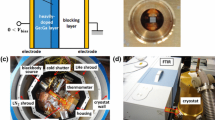Abstract
We are developing far-infrared (FIR) imaging sensors for low-background and high-sensitivity applications such as infrared astronomy. Previous FIR monolithic imaging sensors, such as an extrinsic germanium photo-conductor (Ge PC) with a PMOS readout integrated circuit (ROIC) hybridized by indium pixel-to-pixel interconnection, had three difficulties: (1) short cut-off wavelength (120 \(\upmu \)m), (2) large power consumption (10 \(\upmu \)W/pixel), and (3) large mismatch in thermal expansion between the Ge PC and the Si ROIC. In order to overcome these difficulties, we developed (1) a blocked impurity band detector fabricated by a surface- activated bond technology, whose cut-off wavelength is longer than 160 \(\upmu \)m, (2) a fully-depleted silicon-on-insulator CMOS ROIC which works below 4 K with 1 \(\upmu \)W/pixel operating power, and (3) a new concept, Si-supported Ge detector, which shows tolerance to thermal cycling down to 3 K. With these new techniques, we are now developing a \(32 \times 32 \) FIR imaging sensor.





Similar content being viewed by others
References
H. Dole et al., Astron. Astrophys. 451, 417 (2006)
H. Murakami et al., PASJ 59, S369 (2007)
M.W. Werner et al., ApJS 154, 1 (2004)
G.L. Pibratt et al., Astron. Astrophys. 518, L1 (2010)
M. Fujiwara et al., Appl. Opt. 42, 2166 (2003)
T. Nakagawa et al., Proc. SPIE 8442, 84420O (2012)
M.D. Petroff, M.G. Stapelbroek, U.S. Patent 4,568,960, 4 Feb 1986
T. Suga et al., Acta Metall. Mater. 40, S133 (1992)
T. Wada, et al. in IRMMW-THz2010 (2010)
K. Watanabe et al., Jpn. J. Appl. Phys. 50, 015701 (2011)
H. Kaneda et al., Jpn. J. Appl. Phys. 50, 066503 (2011)
M. Hanaoka, et al. J. Low Temp. Phys. This Special Issue. doi:10.1007/s10909-016-1484-1
H. Nagata et al., IEEE Trans. Electron Devices 51, 270 (2004)
P. Merken et al., Proc. SPIE 6275, 627516 (2006)
P. Merken et al., Proc. SPIE 5498, 622–629 (2004)
H. Nagata et al., AIPC 1185, 286–289 (2009)
H. Nagata et al., IEICE Trans. Commun. E94–B, 2952 (2011)
T. Wada et al., J. Low Temp. Phys. 167, 602 (2012)
K. Nagase, et al., J. Low Temp. Phys. This Special Issue
K. Nagase, T. Wada, et al. in WOLTE-10 (2013)
M. Motoyoshi et al., JINST 10, C03004 (2015)
T. Suzuki et al., PASP 124, 823 (2012)
T. Wada et al., Appl. Phys. Express 10, 102503 (2010)
R.R. Reeber, K. Wang, Mater. Chem. Phys. 46, 259 (1996)
P. Goldsmith et al., Proc. SPIE 7010, 701020 (2008)
Acknowledgments
This work was supported by JSPS KAKENHI Grant Numbers 20244016, 23340053, and 25109005. The authors thank Mitsubishi Heavy Industry Co., Ltd. for their large effort in the fabrication of SAB BIB device. The authors also thank LAPIS Semiconductor Co., Ltd. for their large effort in the fabrication of the FD-SOI CMOS device. The authors thank TDY Inc. and Tohnic Inc. for their support on Ge detector development. The authors thank Tohoku-Microtec Co., Ltd. for their support on micro-cone-shaped Au-bump.
Author information
Authors and Affiliations
Corresponding author
Rights and permissions
About this article
Cite this article
Wada, T., Arai, Y., Baba, S. et al. Development for Germanium Blocked Impurity Band Far-Infrared Image Sensors with Fully-Depleted Silicon-On-Insulator CMOS Readout Integrated Circuit. J Low Temp Phys 184, 217–224 (2016). https://doi.org/10.1007/s10909-016-1522-z
Received:
Accepted:
Published:
Issue Date:
DOI: https://doi.org/10.1007/s10909-016-1522-z




